When selecting a development approach for mobile apps in the USA, the choice between Agile vs Waterfall methodologies is crucial. Agile, characterized by its iterative and flexible nature, is often preferred for mobile app development. It allows for frequent collaboration between teams and stakeholders, ensuring that the app adapts to changing market needs and user preferences. Agile promotes quick releases, facilitating faster time-to-market.
On the other hand, the Waterfall approach follows a linear, step-by-step process. It may be suitable for well-defined projects with fixed requirements. Waterfall offers stability in terms of scope, budget, and timeline but may struggle to accommodate changes mid-project.
Considering the rapidly evolving mobile app landscape in the USA, Agile is generally more fitting. It accommodates updates, enhancements, and feedback-driven improvements, helping apps remain competitive and user-friendly. However, for projects with stable requirements and strict regulatory compliance, Waterfall may still be relevant.
Ultimately, the choice between Agile and Waterfall should align with the specific project’s needs, goals, and the dynamics of the USA’s mobile app market. Balancing flexibility and structure is key to successful mobile app development in this competitive landscape.
What is Agile methodology?

Agile methodology is a project management and software development approach that prioritizes flexibility, collaboration, and iterative progress. It was designed to address the limitations of traditional, rigid development methodologies like Waterfall.
In Agile, projects are divided into smaller, manageable phases called iterations or sprints, typically lasting two to four weeks. Each sprint results in a potentially shippable product increment. Agile teams collaborate closely with stakeholders, allowing for ongoing feedback and adjustments.
Key principles of Agile include customer-centricity, adaptability, and continuous improvement. Agile teams value individuals and interactions over processes and tools, working together to deliver valuable software. This methodology encourages embracing change rather than resisting it, making it well-suited for dynamic and rapidly evolving projects.
Popular Agile frameworks and methods include Scrum, Kanban, and Lean, each with its own set of practices and guidelines. Agile’s emphasis on customer satisfaction, quick deliveries, and a collaborative approach has made it a widely adopted methodology in various industries, including software development, where agility is essential for staying competitive and responsive to changing market demands.
Advantages:
Flexibility and Adaptability:
Agile allows for changes in project requirements, even late in the development process. This flexibility ensures that the final product better aligns with evolving customer needs.
Frequent Deliveries:
Agile promotes regular and incremental product deliveries, enabling stakeholders to see progress and provide feedback throughout the project.
Stakeholder Collaboration:
Emphasizing continuous communication and collaboration between development teams and stakeholders, Agile fosters a deeper understanding of project goals.
Higher Quality:
Ongoing testing and refinement in Agile result in a higher-quality product with fewer defects, as issues are identified and addressed promptly.
Customer-Centric:
Agile places a strong emphasis on delivering value to the customer, ensuring that the end product meets their needs effectively.
Disadvantages:
Complexity:
Agile demands a high degree of collaboration and communication, which can be challenging for large, geographically dispersed teams.
Lack of Predictability:
The iterative nature of Agile may make it difficult to estimate project timelines and costs accurately.
Scope Creep:
Agile’s flexibility can lead to scope creep if not managed carefully, potentially expanding the project beyond its original boundaries.
Resource Intensive:
Agile requires active involvement from team members, which can be resource-intensive and challenging to sustain over long projects.
Not Suitable for All Projects:
Agile may not be the best fit for projects with well-defined, stable requirements, or those subject to strict regulatory constraints.
In conclusion, Agile methodology offers flexibility, customer focus, and frequent deliveries but may require more resources and can be less predictable than traditional approaches. Careful consideration of project characteristics is crucial when deciding whether to adopt Agile.
Use of Agile methodology

The Agile methodology finds common use across various industries and projects where flexibility, collaboration, and adaptability prove essential. Some notable Agile use cases include:
Software Development:
Agile enjoys widespread adoption in software development, allowing development teams to swiftly respond to shifting customer needs, resulting in software better attuned to user requirements.
Product Development:
Agile principles benefit companies engaged in physical product development. They facilitate iterative design, user feedback collection, and continual product enhancement throughout the development lifecycle.
Project Management:
Agile’s principles extend beyond software and product development, aiding project managers and teams in maintaining responsiveness to evolving priorities and stakeholder input.
Marketing and Advertising:
Agile methodologies can be employed in marketing and advertising campaigns, empowering teams to adapt strategies and tactics based on real-time data and market trends.
Research and Development:
Agile practices find application in research and development endeavors marked by innovation and experimentation. Teams can pivot swiftly in response to emerging opportunities or newfound insights.
Education and Training:
Educational settings utilize Agile for course, workshop, and training program design and delivery, allowing adjustments in line with evolving student and industry needs.
Non-Profit and Social Initiatives:
Non-profit organizations employ Agile in projects concerning community development, social change, and humanitarian efforts, facilitating effective responses to dynamic challenges.
Healthcare and Life Sciences:
Agile is pertinent in healthcare and life sciences for research projects, clinical trials, and software development tied to medical devices and health applications.
Financial Services:
Financial institutions turn to Agile methodologies for software development, risk management, and regulatory compliance projects.
Gaming Industry:
Game development studios regularly embrace Agile practices for video game creation and updates, fostering continuous improvement and user-driven enhancements.
In summary, Agile’s adaptability, collaborative nature, and customer-centric approach render it suitable for a wide array of projects and industries. Its value shines particularly in environments marked by constant change and a prioritization of customer satisfaction.
What is Waterfall methodology?

The Waterfall methodology, also known as the Waterfall model, is a traditional project management and software development approach that follows a linear and sequential progression through various phases. It is characterized by its structured and inflexible nature, with each phase dependent on the deliverables of the previous one. Here’s an overview of the Waterfall methodology:
Requirements:
The project begins with a comprehensive gathering of all project requirements. These requirements are documented in detail, often in a requirements specification document.
Design:
After gathering requirements, the design phase commences. During this phase, a detailed design plan is created, including system architecture, data structures, and software specifications.
Implementation:
Following the design phase, development teams start building the system or software based on the predetermined design specifications. This phase involves coding, unit testing, and integration of components.
Testing:
After development, the system undergoes rigorous testing to ensure it adheres to the requirements and functions correctly. Testing often includes various levels, such as unit testing, integration testing, system testing, and user acceptance testing.
Deployment:
Upon successful testing and approval, the product is deployed or released to end-users or customers. This phase typically involves user training and documentation.
Maintenance:
In the final phase, ongoing maintenance and support are provided as required to address any issues, bugs, or updates that may arise after the product is in use.
The Waterfall methodology is known for its structured and disciplined approach but has limitations in accommodating changes once a project is underway. It is best suited for projects with well-defined, stable requirements where changes are costly or discouraged. If changes are needed after a phase is completed, they may require revisiting previous phases, which can be time-consuming and expensive.
Advantages
Clarity and Structure:
The Waterfall model provides a clear and structured framework, making it easy to plan and manage projects. Each phase has well-defined objectives and deliverables.
Predictability:
Waterfall’s sequential nature allows for accurate project timelines, budgets, and resource allocation, as each phase is completed before moving on to the next.
Documentation:
Extensive documentation is produced at each stage, ensuring a comprehensive record of project requirements, design, and development. This documentation can be valuable for audits and compliance.
Well-Suited for Stable Requirements:
Waterfall is ideal for projects with stable and unchanging requirements where deviation or changes are costly or discouraged.
Ease of Management:
Waterfall projects are typically easier to manage and control, as each phase is completed before progressing to the next, reducing complexity.
Disadvantages
Inflexibility:
Waterfall is less adaptable to changes in project requirements, making it unsuitable for projects with evolving or unclear needs.
Late Feedback:
Stakeholder involvement mainly occurs at the beginning and end of the project, which can lead to late discovery of issues or mismatches with user expectations.
Risk of Delivering an Unwanted Product:
Inaccurate requirements gathering at the outset poses a risk of delivering a product that doesn’t meet customer needs.
Longer Time-to-Market:
Waterfall’s sequential approach can result in a longer time-to-market, especially if changes or revisions are needed late in the process.
Limited Room for Error:
Errors or misunderstandings in the early phases can have a cascading effect, making it costly and time-consuming to rectify them later in the project.
In summary, the Waterfall methodology offers structure and predictability but may not be suitable for projects with changing requirements or where early and frequent feedback is critical. The choice between Waterfall and other methodologies depends on the project’s nature and goals.
Use of Waterfall methodology
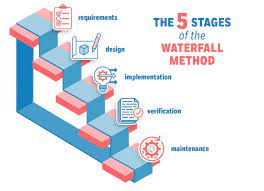
The Waterfall methodology is typically used in projects and industries where requirements are well-defined, stable, and changes during the development process are costly or discouraged. Here are some common use cases for the Waterfall methodology:
Construction Projects:
Waterfall is often employed in construction projects where the design and plans are thoroughly documented before any physical construction begins. Changes to building plans can be costly and time-consuming, making Waterfall a suitable approach.
Manufacturing Processes:
In manufacturing, particularly for mass production of goods, Waterfall methods are used to plan and optimize production processes. The steps and requirements are carefully defined in advance to ensure efficiency.
Regulatory Compliance:
Industries with strict regulatory requirements, such as pharmaceuticals and aviation, may use Waterfall to ensure that all regulatory specifications are met and documented comprehensively.
Infrastructure Development:
Projects related to building infrastructure, such as bridges, roads, and public utilities, often rely on Waterfall to ensure safety and compliance with established standards.
Document Creation:
Waterfall is suitable for projects that involve creating comprehensive documents, such as technical manuals, user guides, and legal contracts, where the content needs to be precise and well-documented.
Hardware Development:
For hardware development, such as designing computer chips or electronic components, Waterfall can be beneficial to ensure that specifications are met and errors are minimized.
Phased Software Projects:
While Agile is commonly used in software development, some software projects, especially those with well-defined requirements, may still opt for a Waterfall approach to ensure thorough documentation and adherence to specifications.
Research Studies:
In certain scientific research projects or academic studies, Waterfall can be employed when the research objectives and methodologies are well-established and any changes could invalidate the results.
Legacy Systems Maintenance:
Maintaining and updating legacy systems where stability and avoiding disruptions are crucial may benefit from a Waterfall approach to carefully plan and implement changes.
In these scenarios, the Waterfall methodology’s structured, linear, and well-documented approach helps ensure that the project proceeds according to plan, with minimal room for deviations or unexpected changes. It is best suited for projects where predictability, rigorous documentation, and adherence to initial requirements are of paramount importance.
When to use Agile vs Waterfall: key factors to consider

Determining when to use Agile versus Waterfall is critical for the success of a project. Several key factors should be considered when making this decision:
Project Requirements and Scope:
Agile: Use Agile when project requirements are expected to change or are not fully known at the outset. Agile accommodates evolving requirements and allows for flexibility.
Waterfall: Choose Waterfall when project requirements are well-defined, stable, and changes are costly or discouraged. Waterfall is suitable for projects with a fixed scope.Project Size and Complexity:
Agile: Agile is often more suitable for smaller to medium-sized projects where frequent communication and collaboration are manageable.
Waterfall: Waterfall may be preferred for larger, complex projects with a higher degree of interdependencies and where a structured approach is necessary.Project Timeline:
Agile: Agile can be more time-efficient for projects requiring rapid delivery of incremental results. It is well-suited for projects with short time-to-market goals.
Waterfall: Waterfall may be preferred when strict project timelines can be established upfront and changes during the project can lead to delays.Risk Tolerance:
Agile: Choose Agile if the project team and stakeholders are open to embracing uncertainty and risk, as Agile allows for adjustments based on emerging information.
Waterfall: Waterfall is appropriate when risk avoidance is a priority, as it aims to define and mitigate risks early in the project.Documentation Needs:
Agile: Agile emphasizes working software over comprehensive documentation. It’s suitable for projects where documentation can be minimal or evolve gradually.
Waterfall: Waterfall produces extensive documentation at each phase, making it suitable for projects with stringent documentation requirements or regulatory compliance needs.Customer Expectations:
Agile: Use Agile when the customer expects regular updates and is open to accommodating changes during the project.
Waterfall: Waterfall may be preferred when the customer prefers a more structured and predictable project management approach.
In conclusion, the choice between Agile and Waterfall should align with project-specific characteristics and objectives. Careful consideration of these key factors will help determine which methodology is the most appropriate for a given project.


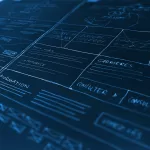




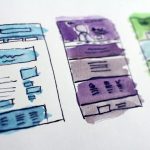
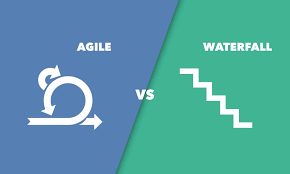
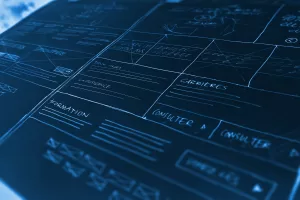








Add Comment